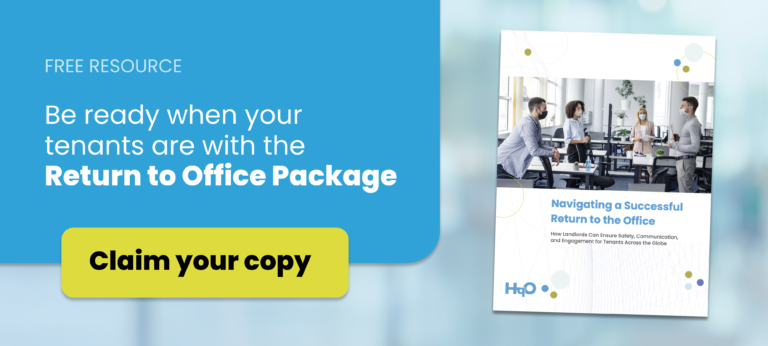As we reflected in our 2021 state of tenant experience report, an incredible amount has changed this past year — including the modern-day tenant experience. As you read on, we’ll walk you through what you need to know about what qualities make a good tenant experience in 2021, including what makes a good tenant and landlord best practices in this new digital era.
The post-pandemic CRE landscape has firmly shifted the value equation away from the office buildings themselves to the people who occupy them. This B2B-to-B2C transformation not only gives office employees more control over where and how they want to work, but also has brought about new circumstances for the industry.
With this in mind, what makes a good landlord in 2021? Good landlords are able to tune into the specific needs of their tenants, no matter where they are. With the drastic changes that COVID-19 has made to the workplace, landlords now have an opportunity to adopt a consumer-first model and embrace the most recent digital disruptions, while diversifying their workplace offerings to meet tenants where they are.
As a tenant experience platform, we’ve seen a lot of trends in the commercial real estate industry. Typically, there is a heavy focus on the tenant (employer) persona when addressing tenant experience needs. However, we’re noticing that there is a real need to consider how other aspects of a building can contribute to a more positive tenant experience, including seeing the building itself as an extension of a landlord’s brand. This more holistic mindset includes considering how the building staff, location, commute, and other finer details can all work together to deliver state-of-the-art customer experiences.
Tenant experience goes beyond building occupants
Since we at HqO know how to enhance the overall tenant experience for commercial office properties, we’ve pinpointed another key element of today’s building ecosystem: those who work behind the scenes can make every property interaction meaningful.
Typically, when we think of the tenant experience, we are, of course, thinking of the tenants and their employees. However, in order to truly deliver a successful customer experience for all members of the building, you need to be thinking about how everything from facilities staff, to external factors such as transportation, to on-site retailers, and more little details can contribute to a modern workplace.
What do we mean by the little details? Some examples include:
- Maintaining a comfortable interior temperature and humidity
- The cleanliness of sidewalks, floors, common areas, and offices
- The condition of finishes and fixtures
- The maintenance of lighting, Wi-Fi connectivity, and power infrastructure
- The smell of the loading dock and freight elevators
- The accuracy of information displays and message boards
- The organization and efficiency of the management office
- The opportunity to hold sustainability initiatives
- The appearance and functionality of building service areas
- Offering digitized building amenities and engaging benefits for employees
- The safety and security of every corner of the building, every system, and every piece of equipment
- The chance to engage with unique building communities
When addressed properly, all of these seemingly disparate parts come together to create a safe, enjoyable, and frictionless place to work for tenants. Some companies are already tuning into the concept of a building as a brand, and have made waves in employee experience by incorporating all aspects of the building workplace. Here are a few prominent examples of technology partners that can enhance the overall tenant experience:
- Wellable is part of the HqOS Marketplace, our ecosystem of best-in-class technology partners and vendors. Throughout the pandemic, the company has reimagined employee wellness, offering creative programs that make it easy for employers to prioritize their occupants’ entire health. They offered virtual on-demand fitness classes like HIIT, Pilates, and mindfulness and meditation. Wellable even launched a solution to help companies hold virtual health fairs where employees can learn about the different health and wellness benefits available to them and engage in fun well-being events.
- Bbot is a smart, mobile ordering solution that seamlessly offers contactless ordering and dining experiences. Operators can create a fully branded, digital menu accessible through QR codes that patrons can scan with their smartphones. Diners can order whatever they want, whenever they want, without ever having to download or sign up for an app.
- LiveSafe is the leading mobile platform for safety and security risk reporting, emergency communications, and COVID-19 health assessments and mitigation. Whether it’s physical safety and security risks, mental health, sexual harassment and assault, or COVID-19 health risks, the LiveSafe Platform provides all of the tools necessary to keep your people informed and safe.
Just as the CRE industry has shifted its focus from physical buildings to the people that occupy them, it is time to widen the industry’s understanding of not only what qualities make a good tenant, but what a holistic tenant experience entails.
All of these distinct components come together to contribute to a “Tenant-First” philosophy that is focused on our customers’ convenience and comfort. At HqO, we know that when we have pride in our building, building occupants will, too. This pride will undoubtedly contribute to their excitement and eagerness to work there.
Today’s challenges require comprehensive solutions
Global adaptations to the COVID-19 pandemic have put “phygital” experiences at the forefront of work and home life, and given rise to unique requirements that property teams must mitigate when returning occupants to their offices. Current-day health and safety concerns are accelerating what was once a trend, and have solidified technology — such as the tenant engagement app and tenant experience platform — as a legitimate building standard.
These technologies play crucial roles in opening day, or the time when a building occupant returns to work at their offices. After all, buildings will be making first impressions all over again, and this welcome plays a heightened role in quelling any hesitations tenants may have upon their return.
Frank Supovitz, Experience Expert, suggests that we consider the following when employees return to offices: “Will there be new services, conveniences, and physical or digital productivity tools available to your tenants that add value to their [building] relationship, and how will they be presented with these new options? Will it be visibly obvious that the building is committed to the protection of the health and safety of all who visit and work there? If commercial buildings are to compete with the at-home work experience, the anxiety of returning to work must be immediately replaced with a more positive kind of energy, the excitement of a homecoming, relief from fears unrealized, and confidence that the office is still, in fact, the highest and best platform for collaboration and innovation.
The complex and challenging circumstances that characterize the return to work have made it necessary to unite all of the people and daily interactions that make up the tenant experience, along with the tenants themselves. From facilities and maintenance staff, to shuttle drivers and security teams, to local retailers, to even a building’s temperature control and lighting, uniting everyone and everything that plays a role in the tenant experience — not only uniting people to people, but also people to place.
In order to achieve end-to-end solutions for every aspect of your tenant experience and facilitate a strong sense of community, whether in-person or remotely, claim your free HqOS demo now.




